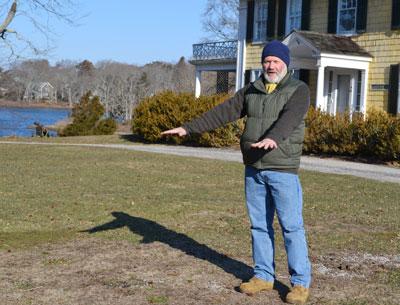Show Celebrates Sylvester Manor

Waving an arm toward the historic Sylvester Manor House on Shelter Island last week, Dr. Stephen Mrozowski, a professor of archaeology, spoke of the charred corncobs he’d found buried there alongside clamshells, the remains of 17th-century Indian clambakes — just an appetizer in the banquet of his findings during excavations from 1998 through 2006.
Alice Fiske endowed a study of the historic property after the death in 1992 of her husband, Andrew, a 13th-generation descendant of Nathaniel Sylvester. Since then, Dr. Mrozowski, director of the Andrew Fiske Memorial Center for Archaeological Research at the University of Massachusetts, has unearthed “hundreds of thousands of artifacts,” he said, among them African-style pottery with European design elements, Dutch building materials, European coins, English and Dutch pipes, multiple building foundations, and one Dutch brick believed to have been part of the original circa-1660 manor house. His findings will be on display at New York University beginning on April 10 in a wide-ranging exhibition called Sylvester Manor: Land, Food, and Power on a New York Plantation, curated by Jennifer Anderson.
Originally 8,000 acres, the manor grounds once encompassed much of Shelter Island, and the 1652 homestead and plantation has remained in the hands of the same family ever since, one of the few in the United States to make that claim. Today, Bennett Konesni, the founder and creative director of the Sylvester Manor Educational Farm, represents the 15th generation of manor stewards. He has established, on the 243 acres that remain, an educational experience that celebrates sustainable food, local history, and arts, with nonprofit programs offered on the grounds surrounding the 1735 manor house and historic windmill.
There are thought to be up to 200 graves on the grounds, the final resting place of Manhansett Indians, enslaved Africans, and European indentured servants, who helped to supply food, timber, and materials to the West Indies — including supplies for the Sylvester family sugar plantations in Barbados — as part of the colonial “triangle trade,” in which slaves were bought on the African Gold Coast with New England rum and then traded in the West Indies for sugar or molasses, which was brought back to New England to be manufactured into rum. Last week, at the request of the board of the educational farm, Dr. Mrozowski and a team from N.Y.U. performed ground-penetrating radar surveys to help determine the locations of the gravesites.
The working plantation became a gentleman’s farm in the 18th century. After the Civil War it became the country estate of E.N. Horsford, a scientist said to have revolutionized industrial food production through the introduction of chemical fertilizers. His daughters, meanwhile, revived the colonial gardens, remnants of which can still be seen on the grounds along with the Georgian manor house, 18th and 19th-century outbuildings, and a rare 1810 Dominy windmill. Mrs. Fiske, who died in 2006, restored the gardens, including trees believed to have been brought to America as cuttings in the 17th century.
Music has also played a part at Sylvester Manor, both past and present. Today, the educational farm holds an annual “Plant and Sing” festival in October and sponsors contra dances and concerts at the Shelter Island School. The most recent, a bluegrass concert by Della Mae, a Boston bluegrass band, was a sellout.
Mr. Konesni can often be seen singing and playing a fiddle or banjo himself, as can his wife, Edith Gawler, who performs folk tunes both locally and professionally. The couple will open a show on April 6, along with the Sylvester Manor Worksongers and Cindy Kallet and Grey Larsen, well-known folk musicians. Traditional Irish music, Scandinavian fiddle duets, old-time fiddle and guitar tunes from southern Indiana, and new original music will be performed at the farm for a fee of $15, $5 for students.
The following week, on April 10, an opening reception for the N.Y.U. exhibition will take place from 6 to 9 p.m. at the Elmer Holmes Bobst Library, 70 Washington Square South. Correspondence with Thomas Jefferson is included in the show, as are land deeds signed by Nathaniel Sylvester with Native Americans — among them Wyandanch, sachem of the Montaukett tribe — in the 1660s. The exhibit will also celebrate two books about Sylvester Manor: “The Manor: Three Centuries at a Slave Plantation on Long Island,” by Mac Griswold, and “Slavery before Race: Europeans, Africans, and Indians at Long Island’s Sylvester Manor Plantation, 1651-1884,” by Katherine H. Hayes.
The exhibition is free and open to the public. Reservations for the opening reception are required, and can be made through [email protected]. Information about guided tours of Sylvester Manor can be found at sylvestermanor.com.
